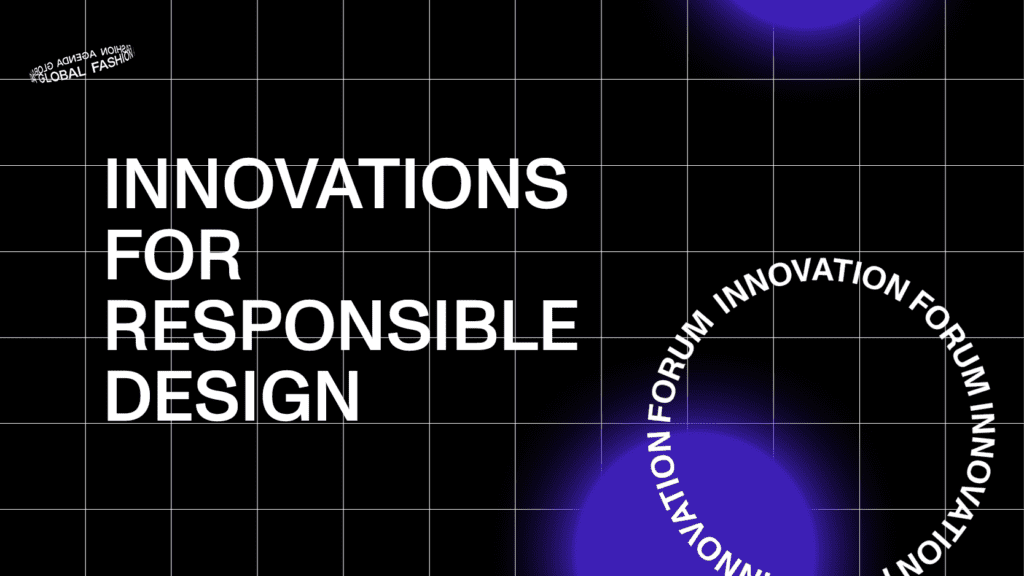Innovations for Responsible Design


The fashion industry is operating at the expense of our planet and the communities that occupy it – with many companies prioritising profitability and convenience over quality and ethics. In the last 15 years, clothing production has approximately doubled yet clothing use has declined by nearly 40%.1 Whilst the industry grapples with the need to slow production rates and citizens reconsider such unabating consumption levels, it is crucial that the clothing which is produced is done so as responsibly as possible. Fashion design is due a total rethink. We need to incentivise practices that are less extractive, in line with circular thinking and respectful of the communities they impact.
Our INNOVATION FORUM, showcases a broad range of solution providers that are paving the way for industry-wide transformation by encouraging responsible design. Below we outline just some of these innovators.
Higg is a sustainability insights platform for consumer goods businesses – delivering software and services for measuring, managing, and sharing supply chain performance data. From materials to products, from facilities to stores, from emissions to working conditions, Higg unlocks a complete view of a business’s social and environmental impact. Higg data can provide invaluable insights during the design process.
Eastman Naia™ is made with sustainably sourced wood, where cellulosic fibre brings the richness of nature to fabrics. Its filament yarn transforms into luxurious, soft, and easy-to-care-for fabrics, while its staple fibre creates eco-conscious blends that are quick-drying and consistently reduce pilling, giving designers more freedom and choice. Naia™ brings nature to fashion with sustainably managed resources; high safety, social, and environmental standards; and a low environmental impact.
MycoWorks developed Fine Mycelium, a proprietary biotechnology that harnesses mycelium to grow a made-to-order natural material that offers the performance of the finest animal leather with lower environmental impact. Recognised globally as a breakthrough in materials science, Fine Mycelium’s durability, customizability and aesthetic features unlock new design possibilities. The customisable, durable material evokes the same quality and emotional response as the world’s finest heritage animal leathers.
PANGAIA is a materials science company on a mission to save our environment. Whilst PANGAIA is a direct-to-consumer brand, it also functions as a B2B company, bringing breakthrough textile innovations and patents into the world, by distributing to brands.
PANGAIA pioneer breakthrough technology like FRUTFIBER™ which repurposes food waste such as banana leaf fibre, pineapple leaf fibre and bamboo into a new, innovative fabric and PLNTFIBER™ which uses renewable, fast-growing plants such as Himalayan nettle, bamboo, eucalyptus and seaweed.
Haelixa has developed an innovative technology to mark, trace and authenticate products from source to retail using a DNA marker. It addresses three key challenges of today’s fashion industry: the need for transparent supply chains, the ability to prove product origin and to support sustainability claims. Its DNA marker creates a unique fingerprint to identify a brand, a supplier or even production lot. The data is highly reliable, because each marker is unique and the info about the origin and journey is safely embedded into the product all time. Offering reliable and genuine material information can incentivise brands to adopt more sustainable materials, starting at the product design phase.
IndiDye® Natural Color Company provides an eco-friendly fibre-dyeing solution based entirely on natural dyes and auxiliaries. The dyeing technology combines high colour fastness with very low water consumption. IndiDye® is applicable to natural, cellulosic and synthetic fibres.
SENSE – IMMATERIAL REALITY exist to support the digital transformation journey through innovative technologies. Among its offerings is Sense Fabric – highly photorealistic and detailed 3D models of fabrics, reproducing all of the features of the real product. This customised solution means that all products in a collection can be viewed in Immaterial Reality – like having a sample in your hands only without the production. This way, products can be designed as efficiently as possible after virtual sampling to ensure minimal waste.
Browse the INNOVATION FORUM to explore the full array of solution providers.
References
1. Ellen MacArthur. Fashion and the circular economy.